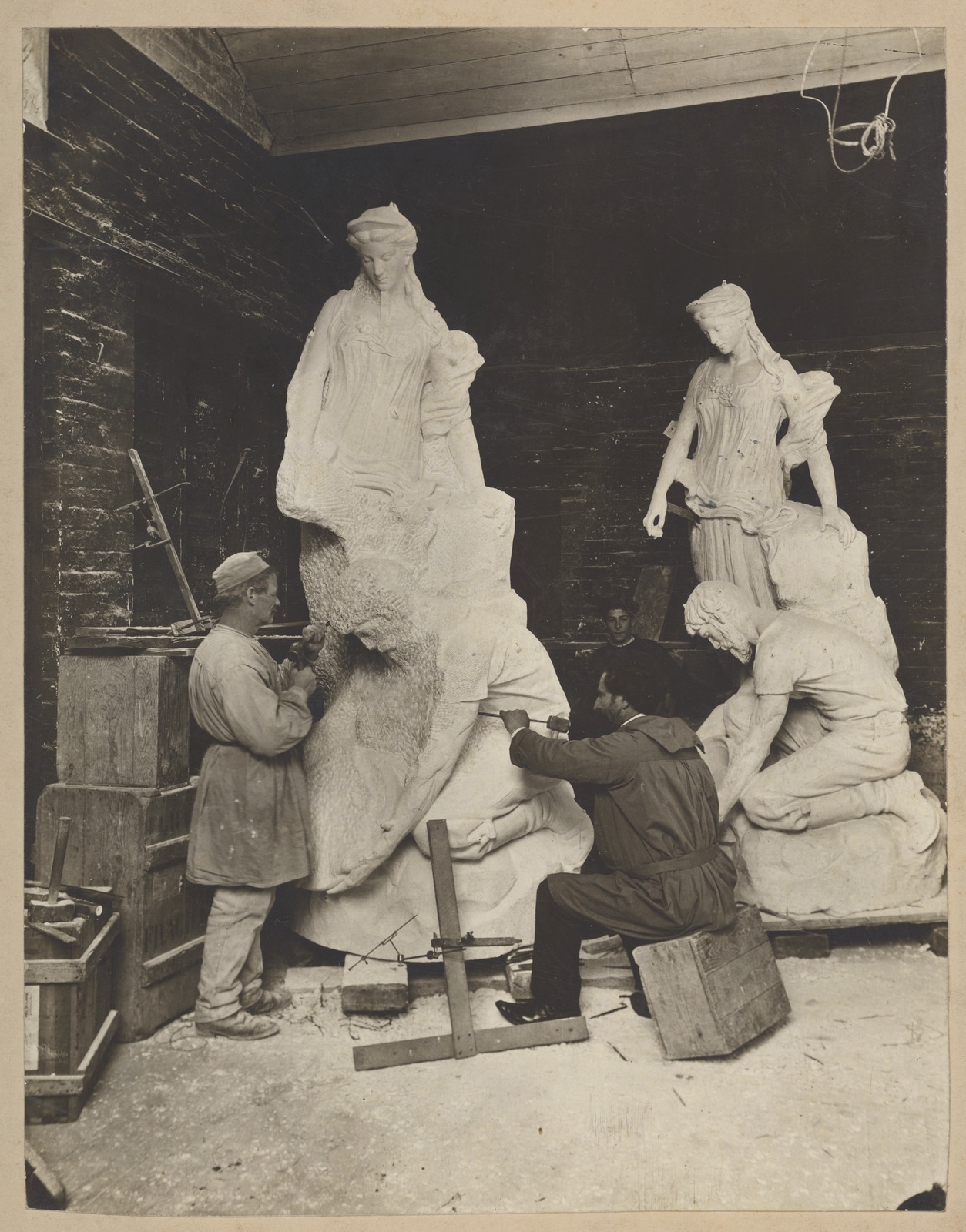One of the largest marble sculptures in the state, Bendigo's Discovery of Gold Monument stands as a proud commemoration of the 1851 discovery of alluvial gold in Bendigo Creek by Mrs Margaret Kennedy.
Constructed in 1906 to the design of Charles Douglas Richardson, the monument was erected with funds raised at a Gold Jubilee Exhibition which celebrated the fiftieth anniversary of the discovery of gold in the area. The monument was unveiled by the Premier of Victoria, Sir Thomas Bent on the 29th of June, 1906. The marble figures stand over nine feet high and are set atop a pedestal of Harcourt granite.
The monument stands between Howard Place, Park Road and the Midland Highway, right in front of the beautiful Rosalind Park.
Plaques on the monument display the following text:
Erected by the Committee of the Victorian Gold Jubilee Exhibition held 1901-2 in commemoration of the discovery of gold in Bendigo, 1851. Samuel H. McCowan, President.
Bendigo Goldfield produced 19,703,956 ozs of gold. Value £78,815,824, between 1851 and 1914, and 21,064,457 ozs valued at £87,003,689 from 1851 to 1941.
The models for the sculpture were described by the artist in 1907:
"The complete figure is reminiscent of all the diggers I have seen ; but after all I had a type, for I got the manner of a man I wanted from a carter I saw in Flinders Lane. One usually takes his type from someone who realises the figure in the mind's eye; but the details of the work are not necessarily carried from the single observation of this one type.
One watches his unconscious subject occasionally to confirm one's idea for the sculptured figure ; but the actual modelling is done from certain models who bear out the desired details of physique and movement.
Five different models, excluding the aforesaid carter, posed for the man with the dish. The figure of Victoria is purely ideal. At the time of the gold discovery, this country was in its teens so the female form is represented young - almost a girl. Three different sitters were used in modelling this figure." - C. D Richardson. (Source:
Trove)
"Two men working on a marble sculpture, one seated on a wooden crate, the other standing, the sculpture is of a female figure in classical dress standing over a man kneeling holding what was to become a pan for panning gold, another complete sculpture behind them".
Source: State Library Victoria
The following text was published in The Bendigo Independent, Tuesday 1st January, 1907. (Source:
Trove)
THE BENDIGO GOLD MONUMENT
OUR MOST HANDSOME PIECE OF STATUARY.
THE MAKING OF A STATUE.
By WILLIAM MOORE in ART SKETCHES.
The particular statue (says the author, who is a son of Mr. Thomson Moore, ex-M.L.A., and a native of Bendigo) we propose to deal with is the work symbolising "The Discovery of Gold." It stands in Howard Place, Bendigo. It represents the largest group in marble which has been sculptured in the State. Designed and modelled by C. Douglas Richards, it is ideal in its conception and yet simple and intelligible in its effect. The dominant figure in the group represents "Victoria". She is seen standing with her left hand resting on a rock of quartz, in which attitude she is supposed to indicate her right to the mineral resources of the State. Our of the richness of her store she bestows a nugget on the gold seeker below. The statue, which is over nine feet high, rests on a pedestal of Harcourt granite fifteen feet in height. This national memorial was unveiled by the Premier of Victoria, June 20, 1906.
The writer then proceeds:
"We measure history by events. The greatest even that marked the past history of this island continent was the discovery of gold in 1851. It increased the small population of a pastoral wilderness by thousands and 'advanced the destinies of Australia five hundred years in one bound'. The importance of this discovery was nowhere more appreciated than at the City of Bendigo, where 14,000,000 ounces of the precious metal were recovered during the fifty years succeeding this event, and the fact that the citizens of Quartzopolis devoted £1100 for the erection of a state to commemorate the discovery showed how they recognised its national importance. The amount mentioned was the surplus realised from the Gold Jubilee Exhibition held at this mining centre 1901-2."
The article continues on to present an interview with the artist, Mr. Richardson, including his aforementioned description of the models used for the sculpture. You can
read the entire article in full here.
Charles Douglas Richardson's 1933 memoir is
available to read online, and includes fascinating accounts of local artists living and working in Victoria in the late 19th and early 20th centuries. The text includes the following quote regarding the Discovery of Gold Monument in Bendigo:
"Probably the most complete public recognition of Richardson's work is to be seen at Bendigo, where his group of the "Spirit of Australia" stooping over a fossicker and dropping gold into his dish as he rinses the alluvial sands of Time was erected commemorate the Jubilee of Gold Discovery in that city. The lyre bird embellishments show the felicity with which sculptors could utilise our native denizens of the bush if given due encouragement". Source:
State Library Victoria.
GEOLOGICAL MAP OF THE BENDIGO GOLD FIELD, 1923
Geological map of the Bendigo gold field which shows historical features in superb detail, including mine shafts/companies, gullies, lines of reef, dams, and sand heaps. Originally prepared in the Bendigo Office, Mines Department, 1923. High quality, durable A1 print in a satin finish. Large, 594 x 891 mm.
Go to online shop.
SEE ALSO


